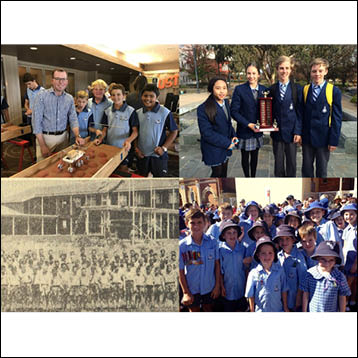A Happy Trinity: Faith, Finance, Commitment
Education that is up-to-date might be a challenge for Australian country towns, neglected by city politicians. This year, Holy Trinity Inverell celebrates 60 years of Christian educational service to local youth, and it offers a broad spectrum of learning in academics, the arts, technical and religious education. The Lasallian District was its initiator in 1963, and is proud of its associated membership today.
FAITH AND COMMITMENT
From the 1950’s, the Bishop of Armidale, Dr. Doody, and the parish priest at Inverell were petitioning for a Catholic school in the town. The problem for the Brothers was a lack of personnel, and hence commitment. The new parish priest, Monsignor Healey, took finance in hand with local fund-raising. The promise of the Brothers was fulfilled finally in 1963, when Brs. James Thomas, Bernadine Brell and Michael Lees began teaching on 3 February. (By this stage, there were 40 Brothers in training in Sydney, and 62 in a junior novitiate).
The three taught 110 pupils in Grades 4, 5-6 and Form 1 and resided in “Roslyn”, a double-storey house adjacent, until a residence was to be built for them. The official blessing and opening on 31 March was a grand affair with over 1,000 attending. In a small close-knit community, it was almost natural for Monsignor Healey to invite Protestant church leaders, in an early example of proto-ecumenism for the Catholic Church community. The former expressed their appreciation at their presence.
FINANCE & COMMUNITY SUPPORT
Bishop Doody hailed the inauguration as “a credit” to the local parish which showed determination in carrying the “heavy burden” of financing the new venture. He praised the generous support of Mr. D H Drummond MHR who, he said, began the University of New England and teacher training there. (The building’s cost of £60,000 was increased with the purchase of the land and the “Roslyn” property to the tune of £82,000. Mr. Drummond had convinced the Commonwealth Bank to advance a loan of £30,000; the Armidale diocese lent £22,000).
The Bishop took the occasion to wade into the state politics of the early 60’s, hoping, he said, that state aid could lighten the burden of providing Christian education, especially with the advent of the revised curricula of the “Wyndham Scheme.” This required science to be taught as a core subject. State secular education and religious schooling was widely discussed in that era, and the latter’s justification as central to Christian belief suggested division and conflict in the public arena.
The local community’s good-will for the new school could be seen in the several generous articles in the “Inverell Times”. The “fine examples of local craftmanship” were lauded for the imposing two-storey, 7-classroom building, including a “science laboratory” and library…”a fine place for learning and fellowship” for the three classes of students. The newspaper’s editorial of 1 April spoke of “the community of Inverell always ready to applaud an effort” and noted “another milestone in district development.”
THE FIRST YEAR
The practical work of learning played out over the first year. The first school Mass had been celebrated on 22 February, and the same day some boys participated in the local schools swimming carnival. A combined carnival was later attended with the Mercy Sisters’ girls. Boys, under Br. Bernadine’s baton, sang at the parish St. Patrick’s Day concert.
Winter saw Trinity teams in several regional football carnivals; a choir recorded two songs on local radio, and in September boys competed in the local eisteddfod. The soccer team beat the High School team, and the athletics carnival was held. The first Speech Night in late November showed the students’ skills acquired in drama, verse-speaking, physical education and singing. Br. James, the Principal, emphasized in his speech the critical role of parents in education, with the sometime questionable prevalence of rock and roll, together with the advent of television.
PARENT / PARISH INVOLVEMENT & CO-EDUCATION
The school’s infrastructure was built up. The Fathers’ Working Committee built concrete cricket wickets, grassed part of a playing field; they planted, with the Brothers, 200 radiata pines one Saturday.
The start of 1964 saw the initial move towards co-educational instruction, with the Mercy Sisters’ senior girls given exclusive use for 2 periods a day of the Science room to satisfy the requirements of the new state curricula. In addition, Mrs. Hayden, the first lay teacher, was employed to teach Grade 4.
Three years later, Holy Trinity, like other regional schools of the Brothers at Cootamundra, Lithgow and Dubbo, became fully co-educational. Four Brothers and three Mercy Sisters - Sr. M Thomas-(later Sr. Maureen Heffernan), Sr. M Bonaventure and Sr. Christopher were on staff with several lay colleagues.
In Easter 1977 it was announced that the Brothers due to their overall reduced numbers, would need to be withdrawn. The “upset and disappointment” witnessed by Br. Vincent Keating, Principal of the time, led to an extension till the end of 1978, when the first lay Principal, Mr. Jim Doran, was appointed.
Br. Vincent engineered the difficulties of transition, fortified by Mrs. Hayden’s weekly apple pie for the Brothers. The Boulos (and later the Michael) family for years had provided gifts of fruit and vegetables, while others, gave cakes regularly and even free dry cleaning. Fr Hanna gave his car when needed for football trips, paying the petrol.
By 1979, all parish primary classes were relocated to the Trinity campus, now a central school. The school website notes: “A multi-million dollar building program in 2010-2011 enhanced learning opportunities, providing specialist performing arts, technology and resource facilities, and refurbishment of the K-2 classrooms in 2013 has ensured that they are contemporary learning spaces”.
LIVING LIFE TO THE FULL – AFTER 60 YEARS
“It is our vision”, says its website, “that Holy Trinity School be an educational institution based on Christian values, where every effort is made to maximise the learning experiences of all members of the school community, so that they may "have life and have it to the full' (John 10:10)”. With 540 students, and 65 staff, it caters for K to Year 10. There is a broad suite of subjects including Food Technology, Agriculture and Trades. As a town school, it is involved in the Sapphire City Parade and the Inverell Show.
The Lasallian connection, as an Associated School, is maintained by the Lasallian Youth Team (LYT) from Sydney providing retreat days for Years 7 -10 over the last 10 years, and for grades 5 & 6 for 5 years. Ms. Mary-Jane Guest, REC, works too with the Lasallian Youth Minister, trained and resourced by the LYT.
CELEBRATING THE DIAMOND EVENT
The 31 March will see a monster Holy Trinity cake shared by the whole community. Two statues – of St. John Baptist de La Salle and Venerable Catherine McAuley are being sculptured currently, and will be unveiled. Other terms will see a student family picnic day, an Open Day, a musical production of the Sixties, and an Open Day for Past Students.
Ms. Guest points to the “welcoming and open” nature of Holy Trinity today, and a sense of the “uplifting and positive” ethos in the school. That the Principal, Mrs. Jilly Rainger and five other staff members, are ex-students, suggests, in addition, that the original Lasallian and Catholic community spirit is alive and treasured in this area of the New England region.
Happy celebrations!
(Author: Br Gary Wilson, Creative Writer).
- Log in to post comments

